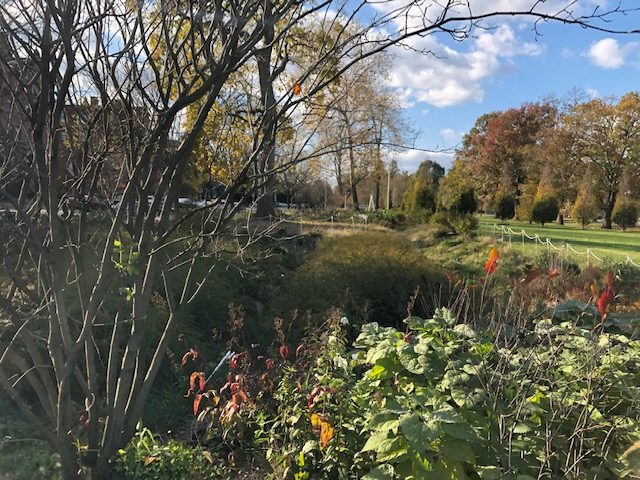
The term green infrastructure was first used in a 1994 report by the Florida Greenways Commission, with the intent of elevating the societal value of natural lands and systems to the same level of importance as engineered (gray) infrastructure. The term has since been incorporated into the planning and design lexicon, with two definitions commonly used in practice. Building on the work of the Florida Greenways Commission, Mark Benedict and Ed McMahon defined green infrastructure as an “interconnected network of green space [at the community or regional scale] that conserves natural ecosystem values and functions and provides associated benefits to human populations.” More recently, the U.S. Environmental Protection Agency defined green infrastructure as stormwater management practices that mimic natural processes in order to absorb and retain runoff close to where it is generated (typically at the site or neighborhood scale).
My own view, as described in Green Infrastructure: A Landscape Approach, a 2013 PAS Report co-written with Ignacio Bunster-Ossa, is that green infrastructure forms a continuum across scales, from site to region and beyond. Moreover, the concept is most powerful when conceived as a system that integrates the built and natural environments while providing multiple benefits for people and ecosystems. The Philadelphia Water Department pioneered this approach through Green City, Clean Waters (2011), the city’s Long-Term Control Plan to address combined storm-sanitary sewer (CSO) overflow using green stormwater infrastructure as an alternative to underground storage tunnels used by other cities. The plan quantified the triple bottom line (economic, environmental, and social) benefits provided by $1.7 billion in investments in green infrastructure over 20 years. Cities such as Boston, New York, and Washington, DC are installing green stormwater infrastructure in response to CSO consent decrees.
The 2013 report and recommendations of the Hurricane Sandy Rebuilding Task Force prioritized the use of green infrastructure by communities in recovery efforts and to reduce risk from future natural disasters. With scientists predicting that the frequency and severity of extreme weather events, the urban heat island effect, and other impacts associated with climate change will continue to increase, green infrastructure has become prominent in discussions of solutions to build community resilience.
But does green infrastructure justify this level of prominence? Green stormwater infrastructure is effective at managing runoff from smaller storms (e.g., under an inch of precipitation) that constitute the vast majority of rainfall events. However, how effective can it be in an era of “superstorms” like Sandy and Hurricane Harvey, which inundated Houston and Harris County with 8 trillion gallons (24 million acre feet) of rainwater during a six-day period – and was the city’s second 500-year storm in two years? And how significant are green infrastructure’s broader co-benefits given the relative paucity of research (the Philadelphia Water Department’s work not withstanding) to quantify them, including longitudinal studies to monitor and assess their efficacy at different scales?
As a long-time proponent of the use of green infrastructure across scales of concern, my answer to the first question above is a qualified yes. On the one hand, neither green nor gray infrastructure is enough to protect communities from the impacts of massive storms like Harvey. On the other, numerous studies demonstrate the human health benefits provided by the urban forest, the largest structural component of green infrastructure in cities. For communities to become more resilient, they will need to develop hybrid “green-gray” stormwater infrastructure solutions and adaptive governance approaches to minimize risks (e.g., land use planning to limit development in vulnerable areas), maximize benefits for people and ecosystems, and increase the ability to bounce back after natural disasters.
One final thought: green infrastructure is a potentially powerful tool to address climate change if deployed at scale because (unlike other solutions) it integrates adaptation and mitigation in one approach. Stormwater management and attenuation of the urban heat island effect are examples of benefits of green infrastructure as an adaptation strategy at the local scale. While the effects of local green infrastructure systems in mitigating greenhouse gas emissions are extremely small, the picture changes as the scale increases. A study by Swiss scientists at the Crowther Lab, published in Science in July 2019, concluded that deployment of green infrastructure at a global scale through tree and ecosystem restoration is “the most effective solution at our disposal to mitigate climate change.” The authors calculated that there is room for an additional 0.9 billion hectares of tree canopy cover in areas that would naturally support forests – outside of existing cities and farmland – which could remove and store 205 gigatons of carbon from the atmosphere. Consider the potential of such a large-scale restoration initiative, coupled with efforts to reverse the loss of existing forests and invest in urban tree canopies, to mitigate greenhouse gas emissions while generating multiple benefits for people and ecosystems! Thinking big enough, perhaps green infrastructure IS much more salvation than hype.
References
Bastin, Jean-Francois et. al. “The Global Tree Restoration Potential,” Science 05 July 2019: Vol. 365, Issue 6448, pp. 76-79 https://science.sciencemag.org/content/365/6448/76/tab-pdf
Benedict, Mark A. and Edward T. McMahon. “Green Infrastructure: Smart Conservation for the 21st Century,” The Conservation Fund, Sprawl Watch Clearing House Monograph Series, 2001. http://wildonesniagara.com/images/greeninfrastructure.pdf
Florida Greenways Commission. “Report to the Governor: Creating a Statewide Greenways System,” December 1994. https://floridadep.gov/sites/default/files/1994FloridaGreenwaysCommissionPlan.pdf
Philadelphia Water Department. Green City, Clean Waters: The City of Philadelphia’s Program for Combined Sewer Control. Program Summary, June 2011. http://archive.phillywatersheds.org/doc/GCCW_AmendedJune2011_LOWRES-web.pdf
Rouse, David C. and Ignacio Bunster-Ossa. Green Infrastructure: A Landscape Approach (PAS Report 571). American Planning Association, 2013. https://www.planning.org/publications/report/9026895/
U.S. Department of Housing and Urban Development. “Hurricane Sandy Rebuilding Strategy Progress Report,” Fall 2014. https://www.hud.gov/sites/documents/HURRSANDREBSTRATPRF2014.PDF
U.S. Environmental Protection Agency. “What is Green Infrastructure?” (website). https://www.epa.gov/green-infrastructure/what-green-infrastructure
Wolf, Kathleen L., Project Director. “Human Dimensions of Urban Forests and Urban Greening” (website). http://www.naturewithin.info/urban.html
